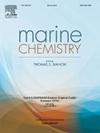层状河口有机质库季节变化对铜生物有效性的影响
IF 2.5
3区 地球科学
Q2 CHEMISTRY, MULTIDISCIPLINARY
引用次数: 0
摘要
本文详细分析了克尔卡河河口铜(Cu)有机形态及其生物可利用性的季节变化。克尔卡河河口是一个高度分层的微潮系统,其特征是河流输入的溶解有机物(DOM)和微量金属较少,但由于旅游活动的增加,夏季人为Cu压力增加。总溶解Cu浓度冬季为3.4 nmol L−1,夏季为25.8 nmol L−1,夏季的大幅增加仅限于盐跃层以上水层。在所有样品中鉴定出两种不同的配体类别,条件稳定性常数logK ' 1 = 13.2±0.5和logK ' 2 = 11.2±0.4。两类配体的溶解有机碳(DOC)和浓度在夏季都高于冬季,这表明它们的原位生产是由初级生产增强和/或微生物活动增强驱动的。在冬季,虽然DOC水平较低(平均63.3 μmol L−1),但盐跃层以上DOM表现出明显的陆地特征,cu结合位点密度较夏季DOM高(平均113.5 μmol L−1)近2倍。结果表明,陆源腐殖质(HS)在冬季的配体库中占主导地位(估计占总配体库的80%),可能对这两类配体都有贡献。虽然HS在夏季仍然是配体库的重要组成部分(估计占总配体库的30%),但该季节DOM的陆地特征最小,表明它们在河口内产生。与冬季相比,夏季盐跃层上方配体浓度的增加伴随着其结合强度的降低(约0.5 log单位),以及DOM分子量的降低,这可能受到太阳照射的影响。环境配体池成功地缓冲了季节性人为Cu输入,使其最具生物可利用性的游离Cu离子浓度远低于文献记载的Cu毒性水平(最大值为2.54 pmol L−1)。DOM的季节性变化导致夏季铜结合能力(33 nmol L−1)比冬季(17 nmol L−1)增加了2倍。尽管夏季的缓冲能力有所增加,但Cu含量正在接近这一安全极限,这可能使其生物利用度增加到一个有关的水平,而在Cu输入最少的冬季,这一风险要低得多。这些结果强调了DOM在减轻季节性人为Cu输入方面的关键作用,同时也强调了进一步研究河口系统在不断变化的环境和人为压力下的长期恢复能力的必要性。本文章由计算机程序翻译,如有差异,请以英文原文为准。
Influence of seasonal changes in organic matter pool on copper bioavailability in a stratified estuary
This work presents a detailed analysis of seasonal changes in copper (Cu) organic speciation and its bioavailability in the Krka River estuary, a highly stratified microtidal system characterized by low riverine input of dissolved organic matter (DOM) and trace metals but experiencing heightened anthropogenic Cu pressures during summer as a result of increased touristic activities. Total dissolved Cu concentrations ranged from 3.4 nmol L−1 in winter up to 25.8 nmol L−1 in summer, with substantial summer increase limited to water layer above the halocline. Two distinct ligand classes were identified in all samples, with conditional stability constants of logK’1 = 13.2 ± 0.5 and logK’2 = 11.2 ± 0.4. Dissolved organic carbon (DOC) and concentrations of both ligand classes were higher in summer than in winter, with strong indications of their in situ production driven by enhanced primary production and/or intensified microbial activity. In winter, despite the low DOC levels (avg 63.3 μmol L−1), DOM above the halocline showed pronounced terrestrial signature with higher density of Cu-binding sites compared to DOM in summer with nearly twice as high DOC levels (avg 113.5 μmol L−1). The results suggest that terrestrial humic substances (HS) dominated the ligand pool in these waters during winter (estimated 80 % of total ligand pool), possibly contributing to both ligand classes. While HS remained an important fraction of the ligand pool in the summer (estimated 30 % of total ligand pool), the terrestrial signature of DOM in this season was minimal, pointing to their production within the estuary. The summer increase in ligand concentrations above the halocline was accompanied by a reduction in their binding strengths (by approximately 0.5 log units) compared to winter, along with a decrease in DOM molecular weight, possibly influenced by solar irradiation. Seasonal anthropogenic Cu input was successfully buffered by the ambient ligand pool, keeping the concentration of free Cu-ions, its most bioavailable specie, well below documented toxicity levels for Cu (maximum of 2.54 pmol L−1). The seasonal DOM variations resulted in a ∼ two-fold increase in the Cu-binding capacity in summer (33 nmol L−1) compared to winter (17 nmol L−1). Despite the increased buffering capacity in summer, Cu levels are approaching this safety limit, which may increase its bioavailability to a concerning level, a risk much lower in winter when Cu inputs are minimal. These results underscore the critical role of DOM in mitigating seasonal anthropogenic Cu inputs, while also highlighting the need for further investigation into the long-term resilience of estuarine systems under shifting environmental and anthropogenic pressures.
求助全文
通过发布文献求助,成功后即可免费获取论文全文。
去求助
来源期刊

Marine Chemistry
化学-海洋学
CiteScore
6.00
自引率
3.30%
发文量
70
审稿时长
4.5 months
期刊介绍:
Marine Chemistry is an international medium for the publication of original studies and occasional reviews in the field of chemistry in the marine environment, with emphasis on the dynamic approach. The journal endeavours to cover all aspects, from chemical processes to theoretical and experimental work, and, by providing a central channel of communication, to speed the flow of information in this relatively new and rapidly expanding discipline.
 求助内容:
求助内容: 应助结果提醒方式:
应助结果提醒方式:


